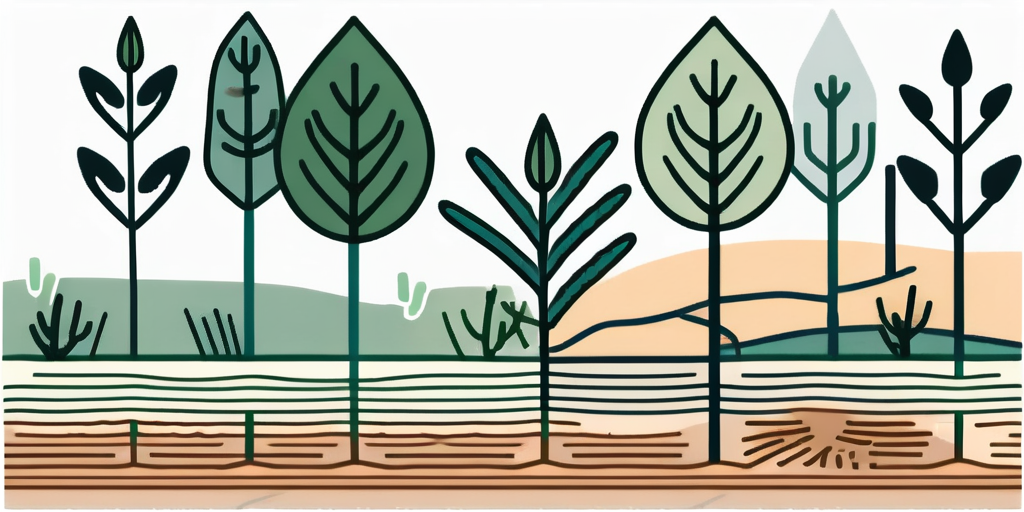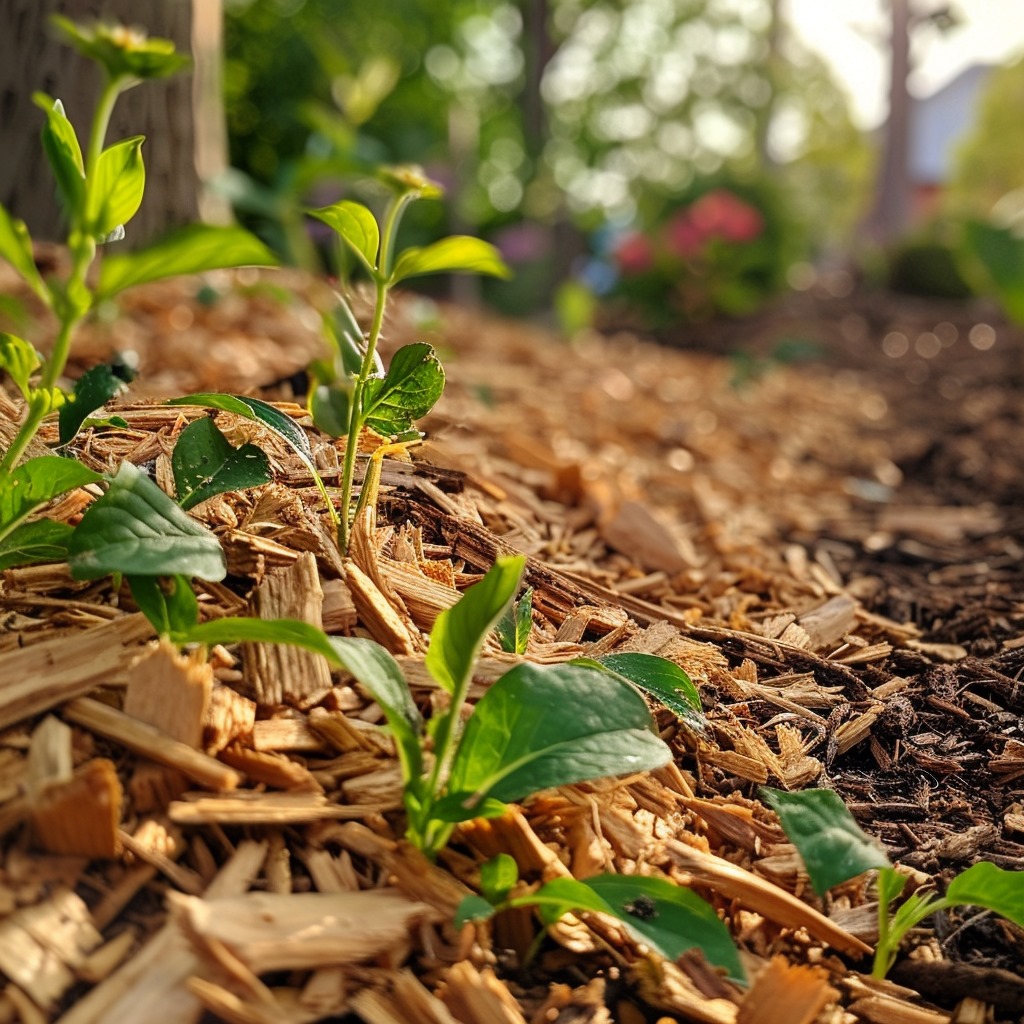During periods of drought, when water becomes scarce and the heat intensifies, our plants are put under tremendous stress. As a result, they become more susceptible to damage and may even struggle to survive. However, there is a simple yet effective solution that can help mitigate these challenges and ensure the well-being of our plants – wood chip mulch.
Understanding the Basics of Drought and Plant Health
Drought is a natural phenomenon characterized by an extended period of significantly reduced rainfall. This lack of water poses a serious threat to the health and vitality of plants, leading to reduced growth, wilting, and even death. To comprehend the benefits of wood chip mulch in combating these effects, we must first explore the impact of drought on plant growth and the role of water in plant health.

During a drought, plants undergo a series of physiological changes to cope with the limited water supply. One such adaptation is the closure of stomata, small pores on the plant’s leaves that allow for gas exchange. By closing these openings, plants reduce water loss through transpiration but also limit the intake of carbon dioxide needed for photosynthesis. This delicate balance highlights the intricate ways in which plants respond to environmental stressors.
The Impact of Drought on Plant Growth
When a plant experiences drought, it faces numerous challenges that impede its growth and development. The lack of water inhibits photosynthesis, the process that plants use to convert sunlight into energy. As a result, the plant struggles to produce nutrients, leading to stunted growth, wilting, and a weakened immune system.
Furthermore, prolonged drought can disrupt the symbiotic relationships between plants and beneficial soil microorganisms. Mycorrhizal fungi, for example, form associations with plant roots and assist in nutrient uptake. However, water scarcity can diminish the activity of these fungi, depriving plants of essential minerals like phosphorus and nitrogen. This disruption underscores the interconnectedness of plant health with the broader ecosystem.
The Role of Water in Plant Health
Water is vital to plant health as it serves many essential functions. It acts as a transportation medium, carrying nutrients from the soil to the different parts of the plant. Additionally, water helps regulate plant temperature and facilitates photosynthesis. Without sufficient water, plants are unable to function optimally and become more susceptible to damage from external stressors.
In addition to its role in nutrient transport, water also provides structural support to plants. Turgor pressure, maintained by the influx of water into plant cells, helps plants remain upright and firm. When water is scarce, plants lose turgidity, causing them to wilt and droop. This loss of rigidity not only affects the plant’s appearance but also hinders its ability to absorb sunlight efficiently for photosynthesis.
The Science Behind Wood Chip Mulch
Now that we understand the challenges posed by drought, let’s delve into the science behind wood chip mulch and its remarkable ability to help plants thrive in dry conditions.
Wood chip mulch has been used for centuries as a natural way to nurture plants and protect soil. Its benefits go beyond mere aesthetics, as it plays a crucial role in maintaining soil health and promoting plant growth.
What is Wood Chip Mulch?
Wood chip mulch consists of small pieces of wood, typically derived from branches, twigs, and tree bark. It serves as a protective layer, covering the soil around plants. When applied adequately, wood chip mulch prevents evaporation, keeping the soil moist and shielding plant roots from extreme temperatures.
Additionally, wood chip mulch acts as a weed barrier, reducing the growth of unwanted plants that compete with your garden for water and nutrients. This natural mulch also encourages beneficial soil organisms, such as earthworms and fungi, which contribute to soil aeration and nutrient cycling.
How Wood Chip Mulch Retains Moisture
One of the primary benefits of wood chip mulch is its ability to retain moisture. By creating a barrier between the soil and the atmosphere, it reduces the loss of water through evaporation. Moreover, the organic material in the mulch slowly decomposes over time, releasing nutrients into the soil and improving its water-holding capacity.
As wood chip mulch breaks down, it enhances soil structure, promoting better drainage and root development. This process mimics the natural forest floor, where decaying organic matter creates a fertile environment for plant growth. The decomposition of wood chips also helps to regulate soil temperature, keeping it cooler in hot weather and warmer during colder periods, which benefits plant roots year-round.
The Benefits of Using Wood Chip Mulch During Drought
Using wood chip mulch during drought can bring about a multitude of benefits for your plants. Let’s explore these advantages in detail.
Preventing Water Evaporation with Mulch
One of the most significant advantages of using wood chip mulch is its ability to prevent water evaporation. By providing a protective layer over the soil, it reduces direct exposure to the sun and wind, which are major drivers of evaporation. As a result, the mulch ensures a more consistent moisture level in the soil, helping plants survive and thrive.
Enhancing Soil Quality with Wood Chips
Wood chip mulch not only retains moisture but also contributes to improving soil quality. As the mulch decomposes, it enriches the soil with organic matter, enhancing its structure and nutrient content. This leads to improved root development, increased nutrient uptake, and overall healthier plants, which are more resilient to drought conditions.
Furthermore, the use of wood chip mulch can also help in weed suppression. The thick layer of mulch acts as a barrier, preventing weed seeds from germinating and competing with your plants for water and nutrients. This not only reduces the need for manual weeding but also minimizes the stress on your plants during dry periods, allowing them to focus their energy on growth and survival.
Adding Aesthetic Appeal to Your Garden
Aside from its practical benefits, wood chip mulch can also enhance the visual appeal of your garden. The natural texture and earthy tones of the mulch create a harmonious and inviting atmosphere, adding a touch of rustic charm to your outdoor space. Whether used in flower beds, around trees, or along pathways, wood chip mulch can elevate the overall aesthetic of your garden while providing essential moisture retention and soil improvement benefits.
How to Properly Apply Wood Chip Mulch for Drought Protection
To maximize the benefits of wood chip mulch, it is crucial to apply it correctly. Let’s take a look at the key considerations when applying wood chip mulch.
Wood chip mulch not only helps conserve soil moisture but also provides a range of other benefits. When applied properly, it can regulate soil temperature, suppress weed growth, and improve soil structure over time. These additional advantages make wood chip mulch a valuable asset in any garden or landscaping project.
Choosing the Right Type of Wood Chip Mulch
When selecting wood chip mulch, it is essential to choose a variety that is free from pathogens and harmful chemicals. Organic mulch, such as wood chips sourced from natural materials, is an ideal choice. Additionally, opt for coarser chips rather than fine ones, as they allow for better airflow and prevent compaction.
Consider the aesthetic appeal of the wood chip mulch as well. Different wood species can offer varying colors and textures, allowing you to enhance the visual appeal of your garden while also providing practical benefits. Mixing different types of wood chips can create a diverse and visually interesting mulch layer.
The Best Time to Apply Mulch for Drought Prevention
The optimal time to apply wood chip mulch is in the early spring, before the onset of hot weather and dry conditions. By mulching early, you provide the soil with an initial moisture boost that can help plants withstand drought stress later in the season. Remember to replenish the mulch as needed throughout the year to maintain its effectiveness.
For maximum drought protection, consider layering the wood chip mulch to a depth of 2-4 inches. This thickness provides adequate insulation for the soil, helping to reduce water evaporation and maintain consistent moisture levels. Be mindful not to pile the mulch against plant stems or tree trunks, as this can lead to moisture-related issues and pest infestations.
Frequently Asked Questions About Wood Chip Mulch and Drought
As we wrap up our exploration of wood chip mulch and its impact on drought protection, let’s address some commonly asked questions:
Can Wood Chip Mulch Harm My Plants?
No, when applied correctly, wood chip mulch poses no harm to plants. However, it is crucial to avoid piling the mulch up against the trunk of the plant, as it can create a favorable environment for pests and diseases. Leave a small space around the base of the plant to promote airflow.
Moreover, wood chip mulch can actually benefit plants by providing a protective barrier against extreme temperatures. During hot weather, the mulch acts as insulation for the soil, keeping the roots cool and preventing heat stress. This additional layer also helps in maintaining a more stable soil temperature, which is beneficial for the overall health of the plant.
How Often Should I Replace the Mulch?
Wood chip mulch is a long-lasting option. However, it is advisable to monitor the condition of the mulch regularly and replenish it as needed. Over time, the mulch will break down and decompose, reducing its effectiveness. Adding a fresh layer every one to two years can help maintain its moisture-retaining capabilities.
Furthermore, the decomposition of wood chip mulch enriches the soil with organic matter, improving its structure and fertility over time. As the mulch breaks down, it releases essential nutrients into the soil, promoting microbial activity and enhancing overall soil health. This nutrient cycling process not only benefits the current plantings but also sets the stage for healthier growth in future seasons.
In conclusion, wood chip mulch is a powerful tool in mitigating the detrimental effects of drought on plants. By preventing water evaporation, enhancing soil quality, and promoting plant health, it serves as a reliable ally in ensuring the well-being of our green companions during challenging dry periods. So, the next time drought strikes, remember the remarkable benefits of wood chip mulch and give your plants the protection they deserve.

